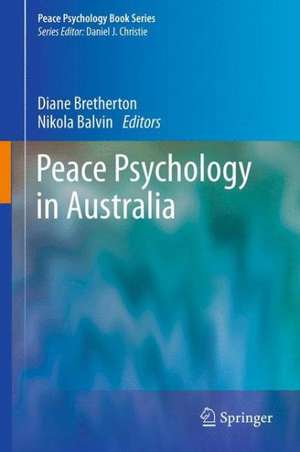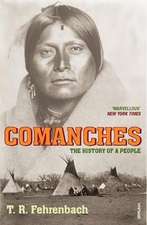Peace Psychology in Australia: Peace Psychology Book Series
Editat de Diane Bretherton, Nikola Balvinen Limba Engleză Paperback – 23 feb 2014
| Toate formatele și edițiile | Preț | Express |
|---|---|---|
| Paperback (1) | 643.99 lei 43-57 zile | |
| Springer – 23 feb 2014 | 643.99 lei 43-57 zile | |
| Hardback (1) | 651.02 lei 43-57 zile | |
| Springer – 16 ian 2012 | 651.02 lei 43-57 zile |
Din seria Peace Psychology Book Series
- 18%
 Preț: 779.26 lei
Preț: 779.26 lei -
 Preț: 361.05 lei
Preț: 361.05 lei - 15%
 Preț: 639.25 lei
Preț: 639.25 lei - 18%
 Preț: 788.54 lei
Preț: 788.54 lei - 15%
 Preț: 699.28 lei
Preț: 699.28 lei - 15%
 Preț: 646.62 lei
Preț: 646.62 lei - 18%
 Preț: 1690.13 lei
Preț: 1690.13 lei - 15%
 Preț: 645.28 lei
Preț: 645.28 lei - 24%
 Preț: 1044.84 lei
Preț: 1044.84 lei - 18%
 Preț: 945.14 lei
Preț: 945.14 lei - 15%
 Preț: 649.54 lei
Preț: 649.54 lei -
 Preț: 386.39 lei
Preț: 386.39 lei - 15%
 Preț: 697.82 lei
Preț: 697.82 lei - 15%
 Preț: 591.14 lei
Preț: 591.14 lei - 18%
 Preț: 1222.94 lei
Preț: 1222.94 lei - 15%
 Preț: 644.82 lei
Preț: 644.82 lei - 15%
 Preț: 649.22 lei
Preț: 649.22 lei - 15%
 Preț: 697.65 lei
Preț: 697.65 lei -
 Preț: 388.72 lei
Preț: 388.72 lei - 15%
 Preț: 647.08 lei
Preț: 647.08 lei - 24%
 Preț: 967.02 lei
Preț: 967.02 lei - 15%
 Preț: 638.89 lei
Preț: 638.89 lei - 15%
 Preț: 650.37 lei
Preț: 650.37 lei - 18%
 Preț: 733.15 lei
Preț: 733.15 lei -
 Preț: 398.74 lei
Preț: 398.74 lei - 15%
 Preț: 644.30 lei
Preț: 644.30 lei - 18%
 Preț: 1116.57 lei
Preț: 1116.57 lei -
 Preț: 365.05 lei
Preț: 365.05 lei - 18%
 Preț: 1116.26 lei
Preț: 1116.26 lei - 18%
 Preț: 1381.26 lei
Preț: 1381.26 lei - 18%
 Preț: 1595.75 lei
Preț: 1595.75 lei - 18%
 Preț: 779.89 lei
Preț: 779.89 lei
Preț: 643.99 lei
Preț vechi: 757.63 lei
-15% Nou
Puncte Express: 966
Preț estimativ în valută:
123.22€ • 129.00$ • 101.96£
123.22€ • 129.00$ • 101.96£
Carte tipărită la comandă
Livrare economică 07-21 aprilie
Preluare comenzi: 021 569.72.76
Specificații
ISBN-13: 9781493900374
ISBN-10: 1493900374
Pagini: 384
Ilustrații: XXVI, 358 p.
Dimensiuni: 155 x 235 x 20 mm
Greutate: 0.52 kg
Ediția:2012
Editura: Springer
Colecția Springer
Seria Peace Psychology Book Series
Locul publicării:New York, NY, United States
ISBN-10: 1493900374
Pagini: 384
Ilustrații: XXVI, 358 p.
Dimensiuni: 155 x 235 x 20 mm
Greutate: 0.52 kg
Ediția:2012
Editura: Springer
Colecția Springer
Seria Peace Psychology Book Series
Locul publicării:New York, NY, United States
Public țintă
ResearchCuprins
Introduction.- Part I. The geohistorical context of peace psychology in Australia.- An overview of traditional forms of Indigenous conflict resolution and peace in Australia.- Indigenous and "settler" relationships, episodic, and structural violence.- Immigration, multiculturalism and the changing face of Australia.- A history of "Psychologists for Peace" in Australia.- National identity, Australian values and outsiders.- Part II. Contemporary issues.- Attitudes towards asylum seekers: The Australian experience.- Battling boatloads of prejudice: An interdisciplinary approach to activism with asylum seekers and refugees in Australia.- Enhancing relationships in school communities: Promoting cooperative conflict resolution and respect for cultural diversity in schools.- Constructing masculinity: Understanding the connection between masculinity and violence.- Having your say: Communication dynamics in effective mediation.- Hidden obstacles to reconciliation in Australia: the persistence of stereotypes.- On the promotion of positive peace for Indigenous Australians: ideas from across the Tasman.- Australian peace psychologists at work: from theory to practice.- Critical theory, community psychology, and community development in Indigenous empowerment.- Part III. Future directions.- Australia's relationship with the land: reckoning with climate chanage.- A peacebuilding paradigm for peace psychology.- A research agenda for the future: new challenges for Peace Psychology in Australia.- Conclusion: peace psychology concepts for the future.
Textul de pe ultima copertă
As the world’s largest island and the only country that is also a continent, Australia holds a unique place among nations. At the same time, given its history of colonialism, racial oppression, and reconciliation attempts, the island also stands as a microcosm of global interest in peacebuilding. Peace Psychology in Australia shows peace efforts making inroads as this large, diverse country undergoes rapid social change.
The book brings into focus the history of relations between Indigenous peoples and the descendents of British and other settlers, the experiences of recent immigrants, and the perspectives of peace professionals on how to achieve a more cooperative and less fragmented society. Chapters identify key factors in successful integration, analyzing the intricate balance between valuing diversity and promoting common bonds, values, and identity. The range of historical and contemporary issues featured includes the country’s hidden history of structural inequity, the rich tradition of Indigenous methods of resolving conflicts, and Australia’s unique possibilities for social justice. And peace psychologists are shown in context, whether advocating for asylum seekers or working with men’s groups to rethink the long-prevailing culture of male domination. Included in this important volume:
The book brings into focus the history of relations between Indigenous peoples and the descendents of British and other settlers, the experiences of recent immigrants, and the perspectives of peace professionals on how to achieve a more cooperative and less fragmented society. Chapters identify key factors in successful integration, analyzing the intricate balance between valuing diversity and promoting common bonds, values, and identity. The range of historical and contemporary issues featured includes the country’s hidden history of structural inequity, the rich tradition of Indigenous methods of resolving conflicts, and Australia’s unique possibilities for social justice. And peace psychologists are shown in context, whether advocating for asylum seekers or working with men’s groups to rethink the long-prevailing culture of male domination. Included in this important volume:
- Immigration and Australian national identity.
- Encouraging respect for diversity in the schools.
- Community development in Indigenous empowerment.
- Stereotypes: hidden obstacles to reconciliation.
- Peace objectives in the era of climate change.
- Practical and research challenges for the future.
Caracteristici
Addresses international relations and changes in the configuration of geopolitical power Situates social relations and conflicts within Australian history to current issues in the country and to other nations Contributors feature international pairing of seasoned scholars with early career peace psychologists, facilitating a dynamic dialogue in the field











